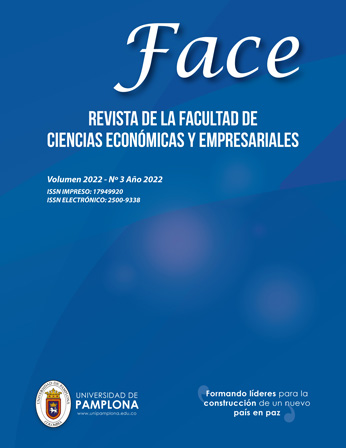The constructed meanings regarding persuasive messages in advertising for light foods, healthy habits, and emotional regulation among college students in Bogotá.
DOI:
https://doi.org/10.24054/face.v22i3.1452Keywords:
persuasion, advertising, food, light, emotion, habitAbstract
The present study aimed to understand the meaning of persuasive messages in advertising for light food brands, as well as healthy habits and emotional regulation in purchasing and consumption among young university students in Bogotá. The hermeneutic method was employed, and a qualitative investigation was conducted, which included the review of secondary sources. Through theoretical triangulation, supported by nutritional, psychological, and marketing perspectives, and by means of focus group sessions with 12 young university students from Bogotá, it was identified that persuasive messages regarding the consumption of light foods are associated with the pursuit of aesthetically beautiful, slim, and fit bodies, promoted by famous individuals or prominent models. These messages induce guilty pleasure and generate motivational states that oscillate between temptation and negativity regarding the consumed product. Although the promotion of healthy habits is linked to the consumption of light foods, the importance of a balanced and healthy diet is emphasized.
Downloads
References
Akrami Yus, Shirin Patricia(2016)Edulcorantes alimentarios y su importancia en la alimentación.[Trabajo Fin de Grado]. Recuperado de: https://eprints.ucm.es/id/eprint/51078/
Chimá,L., Sarmiento, A y Monsalve, J.(2013). Las figuraciones del concepto light en el discurso publicitario colombiano. Recuperado de: https://repository.upb.edu.co/bitstream/handle/20.500.11912/1486/LAS%20FIGURACIONES%20DEL%20CONCEPTO%20LIGHT%20EN%20EL%20DISCURSO%20PUBLICITARIO%20COLOMBIANO.pdf?sequence=1
Desmet, P. M., y Schifferstein, H. N. (2008). Sources of positive and negative emotions in food experience. Appetite, 50(2-3), 290-301. Recuperado do: https://cutt.ly/bxSADL3
Durán, S., Rodríguez, M. D. P., Cordón, K., y Record, J. (2012). Estevia (stevia rebaudiana), edulcorante natural y no calórico. Revista chilena de nutrición, 39(4), 203-206
Flórez, J. F., Góngora, C., Pacheco, I., & Cortázar, L. O. (2014). Análisis de consumo de losalimentos funcionales. Exploración de percepción de producto, marca y hábitos de consumo a partir de los cereales light. Libre Empresa, 11(1), 119-136.
Friestad, M., y Wright, P. (1994). The persuasion knowledge model: How people cope with persuasion attempts. Journal of consumer research, 21(1), 1-31.
Garzón Medina, C., Sánchez Arismendi, A., Naranjo del Giudice, O., Giraldo Oliveros, M. E., González Ternera, R. J., Sánchez Baltasar, L. B., ... & Linero Bocanegra, J. P. (2018) Consumo, prácticas y mercados emergentes. Reflexiones del consumidor latinoamericano. USTA 440
Garzón Medina. C. y Barreto, I. (2013). Prácticas alimentarias y significados de alimentos light de familias de un sector urbano de Bogotá. Suma psicológica, 20(1), 89-99. Recuperado de: https://cutt.ly/BxSHE4y
Goffman, E. (1974). Frame analysis: An essay on the organization of experience. Harvard University Press.
González, C. A., y Ham-Chande, R. (2007). Funcionalidad y salud: una tipología del envejecimiento en México. Salud pública de México, 49, s448-s458.Gross, J. (1989).Emotional expression in cancer onset and progression. Social Science and Medicine, 28,1239–1248.
Melchor, M., Rodrígez, J. D., y Díaz, M. A. (2016).Comportamiento de compra y consumo de productos dietéticos en los jóvenes universitarios. Pensamiento & Gestión, (41), 174-193.Recuperado de: https://www.redalyc.org/pdf/646/64650087008.pdf
Nielsen, (2018). 4 de cada 10 colombianos están cambiando a la versión saludable de su producto preferido. Obtenido de:
Patel, K. A., y Schlundt, D. G. (2001). Impact of moods and social context on eating behavior.Appetite, 36(2), 111-118. Recuperado de: https://cutt.ly/PxS2CHW
Pérez, O. G., y Bello, N. C. (2017). Regulación emocional: definición, red nomológica ymedición. Revista mexicana de investigación en psicología, 8(1), 96-117. Recuperado de: https://www.medigraphic.com/pdfs/revmexinvpsi/mip-2016/mip161g.pdf
Pérez-Rodrigo, C., y Aranceta, J. (2001). School-based nutrition education: lessons learned and new perspectives.Public Health Nutrition, 4(1a), 131-139.
Pérez-Salgado D, Rivera-Márquez A, Ortiz-Hernández L. (2010). Publicidad de alimentos en la programación de la televisión mexicana: ¿los niños están más expuestos?Salud Pública México;52(2):119-126.
Ley 1355 (2009). Por medio de la cual se define la obesidad y las enfermedades crónicas no transmisibles asociadas a ésta como una prioridad de salud pública y se adoptan medidas para su control, atención y prevención. Diario Oficial. Colombia: Congreso de la República.
Resolución 333. (2011). Por la cual se establece el reglamento técnico sobre los requisitos de rotulado o etiquetado nutricional que deben cumplir los alimentos envasados para consumo humano. Colombia: Ministerio de la Protección Social.
Rozendaal, E., Van Reijmersdal, E., y Buijzen, M. (2019). Children's understanding of persuasion. The International Encyclopedia of Media Literacy, 1-6. Recuperado de: https://cutt.ly/exSCwGv
Salvy, S. J., Miles, J. N., Shih, R. A., Tucker, J. S., y D’Amico, E. J. (2017). Neighborhood, family and peer-level predictors of obesity-related health behaviors among young adolescents. Journal of Pediatric Psychology, 42(2), 153-161. Recuperado : https://academic.oup.com/jpepsy/article/42/2/153/2622421?login=true
Spinelli, S., Masi, C., Zoboli, G. P., Prescott, J., y Monteleone, E. (2015).Emotional responses to branded and unbranded foods. Food Quality and Preference, 42, 1-11.
Vieira, C. M. (2018). La publicidad y el consumo de alimentos funcionales en Portugal (Doctoral dissertation, Universidad Complutense de Madrid). Recuperado de: https://eprints.ucm.es/id/eprint/47931/1/T39997.pdf
Van Reijmersdal, E. A., Boerman, S. C., Buijzen, M., y Rozendaal, E. (2017). This is advertising! Effects of disclosing television brand placement on adolescents. Journal of youth and adolescence, 46(2), 328-342. Recuperado de: https://link.springer.com/content/pdf/10.1007/s10964-016-0493-3.pdf
Vilaplana, M.(2008). Alimentos light y dietas milagro. OFFARM. 27 (4), p. 1-5. Recuperado de: https://www.elsevier.es/es-revista-offarm-4-pdf-13120070
Urrutia, M. (2021). Publicidad ¿persuasión o manipulación? Recuperado de: https://repositorio.inci.gov.co/handle/inci/18823
Young, E. M., y Fors, S. W. (2001).Factors related to the eating habits of students in grades 9–12.Journal of School Health, 71(10), 483-488. Recuperado de: https://cutt.ly/xxSFASK
Young, E. M., Fors, S. W., & Hayes, D. M. (2004). Associations between perceived parent behaviors and middle school student fruit and vegetable consumption.Journal of nutrition education and behavior, 36(1), 2-12. Recuperado de: https://cutt.ly/OxSGv7G
Downloads
Published
How to Cite
Issue
Section
License
Copyright (c) 2022 FACE: Revista de la Facultad de Ciencias Económicas y Empresariales

This work is licensed under a Creative Commons Attribution-NonCommercial-ShareAlike 4.0 International License.





